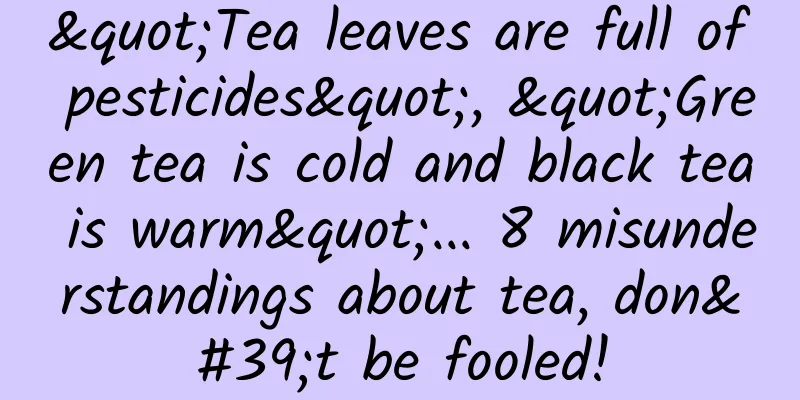"Tea leaves are full of pesticides", "Green tea is cold and black tea is warm"... 8 misunderstandings about tea, don't be fooled!

|
There has never been a plant that can transform into so many images and flavors in cooperation with humans like tea; there has never been a commodity that can have so many attributes and possibilities like tea. Under the diversified demands and marketing methods of modern society, many true and false legends have also appeared in society. Here, we have sorted out 8 familiar ones and analyzed them one by one. 01 Rumor 1: “The older the tea is, the more valuable it is. Storing tea is like buying original shares.” The price of tea is mainly determined by the production link and the circulation link. For the same kind of tea and regular products, the better the quality, the higher the price. Generally speaking, the cost of fresh leaves of spring tea is higher than that of summer tea, and the first harvest of spring is definitely higher than that of the end of spring; a pound of fat and solid buds will be much more expensive than leaves, and for tea made from mature leaves, the price of young leaves is higher than that of old leaves. The so-called "old tea" tea, such as white tea and black tea, is not very palatable when they are just produced, and it takes a period of time to complete the transformation of the best flavor. In other words, storage is also a part of the production process of "old tea". But even for this kind of tea that pays attention to "old tea", not all products are delicious after being stored for a long time. It also depends on whether the quality meets the standards when it is just produced and whether the storage process is proper . Compared with fresh food, tea leaves, as dry food, are easier to preserve, but it does not mean that they can be preserved indefinitely. Most teas have a "best tasting period". After this period, the tea will no longer taste good. For example, the best tasting period for regular green tea and black tea is between 12 and 36 months. Even for the type of tea that emphasizes "old tea", there is no need to overemphasize the financial attributes of tea and operate it as a financial derivative. After all, as a food, its value is reflected in its being drunk. 02 Rumor 2: “Drinking tea must be organic Non-organic tea is full of pesticides.” The planting and processing methods of organic tea basically follow the laws of nature, allowing tea trees and various animals, plants and microorganisms in the tea garden environment to survive according to the natural law of survival of the fittest, and minimizing human influence. This makes the tea industry, which depends on the weather, even more uncertain. The uncertainty of fresh leaf yield, low efficiency of manual weeding, high cost and limited efficiency of organic fertilizers, etc., make the cost of tea that "truly meets organic standards" very high . And are they delicious? Ultimately, it depends on the craftsmanship of the tea maker. Non-organic tea gardens have lower management costs and high fresh leaf yields. As long as the tea maker performs normally and guarantees the standard quality of tea, it will be fine. Non-organic tea gardens use pesticides to sterilize and kill insects, but it is not difficult to "comply with national regulations" for pesticide varieties, degradation cycles, application time and parts, etc., rather than "all pesticides" as people have spread rumors . If you calculate the "amount of pesticides" ingested through drinking tea every day, it is actually far less than the pesticides that may be ingested through regular diet. A simple summary: The "pesticide residues" that may be ingested through drinking tea are much less than those of other agricultural products such as vegetables, fruits, grains and oils. 03 Rumor 3: “You must use hot water to make tea” It is a customary practice for Chinese people to brew tea with hot water, so we have been taught since childhood that water should be boiled before brewing tea. It is not good to brew tea with lukewarm water, and it is not polite. Tea should not be drunk when it is cold, etc. In the past, sanitary conditions, especially water purification, were not as good as they are now, so boiling water was the main method of sterilizing and purifying water. Now, many people drink water directly, so it is not so important whether it is boiled or not. As a result, there are more choices and flavors for brewing tea. Some teas have a high caffeine content, such as most green teas. Hot (boiling) water makes them bitter. We lower the water temperature to 80°C or even lower, which can reduce the amount of caffeine dissolved in the water, and the tea will not be so bitter. Some people like to drink cold drinks, so they can use cold water or even ice water to soak the tea leaves. As long as the soaking time is long enough (usually more than 1 hour), the aroma and taste of the tea leaves can still enter the cold water, which is called ice-cold brewed tea. Moreover, compared with sugary cold drinks, the calories of original cold brewed tea are zero, making it the first choice for people who control calories. 04 Rumor 4: “You have to use expensive tea sets to make tea. Otherwise, you can’t make good tea.” Lu Yu, who lived in the Tang Dynasty and was revered as the "Tea Saint" by later generations, once said: "The teaware is the father of tea." Therefore, since ancient times, tea drinkers of all classes have paid great attention to the teaware used to make and drink tea. They must be expensive, beautiful, and have a history or be particular. Drinking tea with a large jar or a glass canning bottle is always considered "vulgar." It is understandable to use professional teaware to make and drink tea to show the importance of tea and guests. But professional teaware is not necessarily expensive. The key is to see how we define "professional." More importantly, making tea is a technical job. Practice makes perfect. Even if we don't have a convenient teaware at hand, we can make good tea with professional knowledge and skilled skills. Simply put, whether the teaware is professional or "amateur", expensive or ordinary, whether it can make "good" tea depends mainly on the brewing skills. Expensive teaware presents the "ritual sense" and visual aesthetics of brewing tea, which has little to do with whether the brewed tea is delicious. 05 Rumor 5: “Tea is bitter and astringent, not tasty” In the past, there was a saying: If it is not bitter and astringent, it is not called tea. Now it seems that it is a bit of a joke, to help those bitter teas, and also reflects that in the era of material shortages, strong tea will bring people more sense of security. Nowadays, tea has a rich variety and good craftsmanship. With the smooth logistics, people have more choices in tea flavors. There are bitter but not astringent, there are also those that are neither bitter nor astringent, and there are those that are bitter but sweet. When modern people make tea, they pay more attention to the adjustment of the amount of tea, the temperature of the water and the soaking time, striving to brew a tea soup with balanced flavor and refreshing aftertaste, so as to experience the harmonious beauty of tea. 06 Rumor 6: “Green tea is cold, black tea is warm” The dry green tea is green, the tea soup is light yellow, and tastes slightly bitter, so it brings a cool feeling visually and astringent taste. As for black tea, the dry tea is mostly dark brown, and the tea soup is a pleasing red, which naturally gives people a warm and romantic feeling. The tea soup of most black teas is less bitter. High-quality black tea is brewed properly and has a slight honey aroma, which makes people feel warm. In addition, some traditional culture enthusiasts simply and crudely apply the theory of yin and yang and the five elements to tea leaves, so many people mistakenly believe that "green tea is cold and hurts here and there", "black tea warms the stomach and beautifies the skin..." In fact, the fundamental difference between green tea and black tea lies in the production process. In the production of green tea, there is a key step called "killing the green", which is to inactivate the oxidase in the fresh leaves through high temperature to prevent the oxidation and discoloration of tea polyphenols (the tea industry calls this process of "tea polyphenol oxidation and discoloration" "fermentation", which is different from the biological meaning of "fermentation"). Black tea, on the other hand, completely oxidizes tea polyphenols into theaflavins and thearubigins, which is called "fully fermented tea", thus producing a flavor different from green tea. In other words, the same fresh leaves of tea trees can be made into both green tea and black tea. The oxidation of tea polyphenols (that is, "fermentation" as the tea industry calls it) only affects the color, aroma and taste of tea. The claim that the soluble components that can enter the human body produce "warmth" or "coldness" is just a far-fetched conjecture . 07 Rumor 7: “You can only buy good tea in tea-growing areas” China's tea-producing areas are spread over more than 20 provinces, municipalities and autonomous regions, all of which are beautiful places with outstanding people. For tea drinkers, it is naturally desirable to have the opportunity to visit tea-producing areas. Many people believe that by going deep into tea-producing areas, they can buy authentic, reliable, high-quality and low-priced tea from local tea farmers, leaving the middlemen behind. This idea is actually a bit "naive". Whether you can buy good tea in a tea-producing area depends on whether you have professional identification ability for tea and whether there are fixed and reliable channels . Most of the tea farmers have "raw tea", that is, tea that has not been refined through picking, screening, stacking, blending and other refining links, and is not a standardized product. Faced with a large number of primary agricultural products with different flavors and good and bad, it is difficult for people who have not undergone long-term professional training to select standard and good tea that suits your taste. For most people, "looking and smelling" is essentially the same as "blind guessing". Tea farmers work hard to make tea, so they naturally hope to make friends with stable and large-volume customers. For tourists who visit occasionally, they usually just buy a few kilograms of tea, and the truly high-level tea farmers may not be interested in receiving them. Whether or not you can buy good tea in the tea-growing areas and whether or not you can buy good tea at a favorable price that meets your expectations depends mainly on luck. 08 Rumor 8: “Drinking tea can cure all diseases” "There are many taboos in drinking tea, otherwise it will harm your body" In ancient times, medicine, transportation, and information were not well developed. Tea and many kinds of plants around people all played a role in relieving pain. This was related to people's understanding of diseases and the limitations of treatment methods at that time. With the continuous progress of modern medicine, the understanding of diseases and the prevention and treatment methods are also constantly strengthening. Tea should also unload the "historical burden" and return to the simple image of "delicious beverage". At most, it can undertake some new tasks of "cultural envoy". Modern science has indeed discovered that there are "many kinds" of biologically active ingredients in tea that are beneficial to the human body, which have been interpreted by merchants as various "effects". In fact, the amount of tea we drink every day is limited, and the "active ingredients" that can be ingested are not enough to reach the "effective dose" in scientific experiments, so we can't expect these substances to play any role in the body. Compared with the ancient "cure for all diseases", the attribute of tea as a "low-calorie healthy beverage" is more scientific, more down-to-earth, and more popular in modern society. As for the widely circulated "taboos" of drinking tea, it depends on the individual's physical condition and cannot be generalized. Author: Yu Jiaping Reviewer: Yun Wuxin, PhD in Food Engineering, Purdue University, USA |
>>: How does gravity come about? Who has figured out its origin?
Recommend
VisionMobile: IoT Developer Program Best Practices Survey (Infographic)
199IT original compilation Developers value the c...
Guangdiantong optimization tips and precautions
Guangdiantong is a DSP advertisement based on Ten...
In Chaoshan, why is “treating you to drink porridge” the highest treatment?
Loading long image... Source: China National Geog...
Liu Heng's "Name Studies" 81 Numerology Determines the Changes in Life
Introduction to the content of the training course...
Nuclear power heating is being used in many places in China. Is it safe? Will it be widely used in the future?
In Shandong, Liaoning, Zhejiang and other places,...
Promotion and traffic generation: How to use Zhihu to attract traffic and fans?
I believe everyone knows Zhihu, which gathers pro...
Now that both black boxes have been found, can we recover the truth? Why isn't the data transmitted back to the ground in real time?
Experts in this article: Liu Yuxuan, Tianjin Fore...
Post-90s beauty operator: How I planned an event with 10 million daily traffic in 5 days!
I'm Zongzi, a post-90s planner who combines a...
Stop worrying about Google Glass
In recent days, the Google Glass incident has att...
MX4 Pro proves that there is still a market for being an Apple disciple
[[123302]] The long press conference finally ende...
Where does a fart go after you hold it in? Here's the stinkiest science lesson ever
Many people may have had the embarrassing moment ...
How to increase website traffic? 100 Ways to Increase Website Traffic
1. Add a blog to your website. If your website is...
For the sake of his children, he drank 100 doses of vaccine
In the summer of 1955, a strange disease appeared...
"Iris photography" suddenly became popular! Is it safe? Doctors warn...
Recently, a new type of "iris photo" ha...
What do you think of the suddenly disappearing stars and twinkling stars?
A strange star flickering in the center of the Mi...









